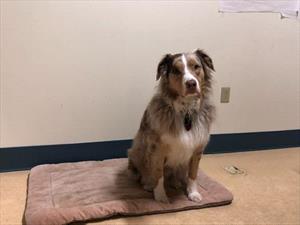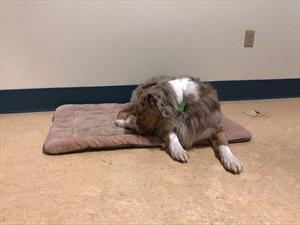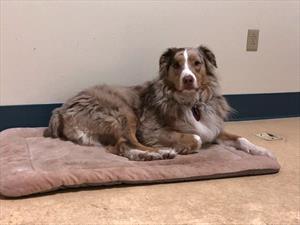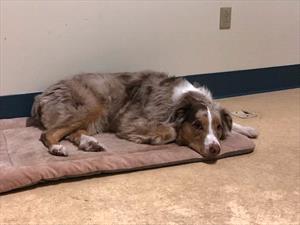Step 1: Reward for Interacting With the Mat
Mat training is an important foundation skill to teach any animal. It can begin the moment the dog looks at the mat, goes near the mat, or steps onto the mat by marking the behavior with a click or word, to let him know this is what you want. Marking is a signal given to your pet to indicate that they are doing what you expect.
Dog sitting on mat attentively

Photo courtesy of Pat Koven
Step 2: Shaping the Behavior
If he does not willingly step onto the mat, you may also position yourself on the opposite side of the mat from your dog and mark as he steps on it to come to you. At first it may only be one paw, but you will then begin shaping for two, then three, then four feet by increasing the value of the treat. Kibble is the lowest and chicken, or hot dogs or cheese being the highest.
- Look at mat. Mark then treat on the mat.
- Touch mat with a paw. Mark then give higher value treat on the mat.
- One foot on mat. Mark then give higher value treat on the mat.
- Two feet on mat. Mark then give higher value treat on the mat.
- Four feet on mat. Mark then give highest value treat on the mat.
You are marking any positive interaction he has with the mat that is getting him to your end goal of lying down on the mat. He will quickly learn that good things happen in the form of delicious treats on this mat and he will want to be on this mat.
Dog lying on mat

Photo courtesy of Pat Koven
Step 3: Lie on the Mat
Any behavior he displays that is closer to lying down on the mat earns him a higher value treat, such as chicken, cheese, hot dog. Any other behaviors he displays while on the mat earns lower value treats such as his kibble. He will soon realize that lying down earns him a better treat or “paycheck”. If necessary, to encourage lying down, you may use the down cue a few times, mark and reinforce with a high value treat. Then he should offer a down on his own and be given several high value treats while you continue to reward other displayed behaviors with lower value treats.
Next walk away a few steps and encourage your dog to follow you. Then stand still and your dog should return to the mat for more treats. Reinforce with low to medium value treats for going to the mat and high value for lying down on the mat. When your dog is successfully returning to his mat after 3-5 repetitions at this distance, take a couple of further steps away from the mat. Repeat a few more times. If he is not consistent at the new distance, take a step back closer to the mat, to the last place he was successful.
Step 4: Adding Duration - Stretching the Time Between Treats
When the dog is consistently lying on the mat, hold off on reinforcing for one second, then two seconds, five seconds and so on to teach the dog to hold the down position on the mat. If he continually sits up, go back a step in the process.
Step 5: Introducing a Cue - Pairing a Word to Name the Behavior
When the dog is going to his mat and lying on it, holding the position and looking to you for a treat, introduce your cue. It can be any word you prefer. Mark followed by a treat. Use this cue to send him to a down on a mat from a foot away, two feet away, then greater distances. Reinforce with high value treats.
Dog down on mat

Photo courtesy of Pat Koven
Step 6: Down On a Mat
When you have a high rate of success of going to the mat on cue and lying down, you can start introducing distractions. Gradually increase distractions by reinforcing with a high-level treat for a held down position.
Distractions can include:
- Moving the mat to other areas in the room, then to other rooms, then into the car or on the deck.
- Walking around the mat while he is lying down on it.
- Whistling, waving your arms, clapping, doing jumping jacks.
- Having family members walking through the room quietly then have them clap, whistle, or sing.
- Having doorbells or phones ring.
- Having people come in the front door.
Step 7: Teaching a Release Word
To reduce your dog’s confusion a release word, can be taught to let your dog know he it is okay to leave the mat and the training session is over. Using a cue, such as take a break, or all done. Remember, train in baby steps. Go back a step if there’s any point at which your dog is not making progress.
Training sessions should be short, 5-10 minutes, once daily to start but can lengthen as his attention span grows. Always end on a good note with a game afterward. The next practice session should begin at the last successful step.
Step 8: Relaxing On the Mat
When your dog goes to his mat on cue, lies down and remains in position until released training shifts to teaching a much deeper state of relaxation.
To accomplish this, reinforce with low value treats:
- any shift of the dog’s body onto his side.
- his head turning on the side.
- his chin flat on the floor.
- his shoulders shifting to the side.
- his tail relaxing behind his body along the floor.
- and finally, his respiratory rate decreasing.
We do not use the clicker for marking these behaviors instead use low value treats. The clicker can overstimulate some dogs as that sound usually means tasty treats. Rely on soft spoken cues and less exciting rewards. Choose your cue, such as relax or rest, and for each level of relaxation use kibble less frequently. Remember to remain still and close to your dog to watch his body language closely. Always offer treats close to his mouth so he does not bounce up for it.
As the dog progresses through each level of relaxation, say the cue more softly, more deeply and give fewer rewards. The steps of relaxing become self-reinforcing.
The end goal is for the dog to be flat out on his side, mouth relaxed, eyes closed, deep slow breaths, or asleep. Think of this as deep meditation for your dog. Eventually the mat becomes the cue for a happy, restful place the dog wants to be during times of stress.
Dog relaxed on mat

Photo courtesy of Pat Koven